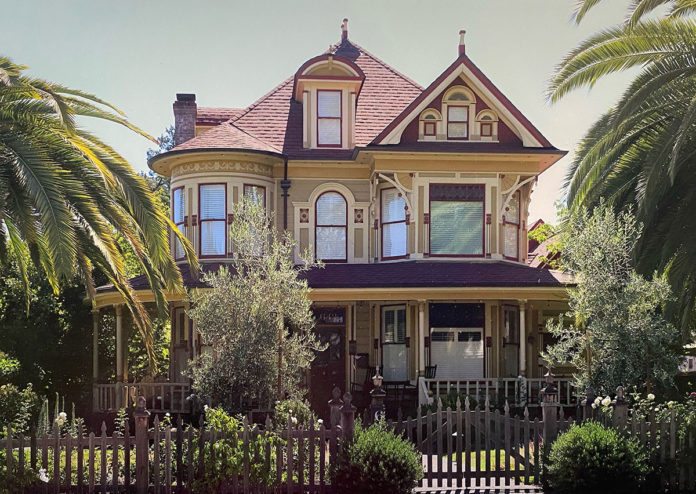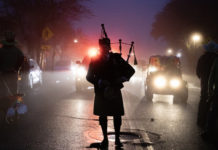
For the second year in a row, the docents of the Healdsburg Museum and Historical Society make history come alive in the Healdsburg Plaza, on successive Saturdays until Aug. 31.
“The Healdsburg Museum may be closed until late July to install a new exhibit, but you can get your Healdsburg history fix Saturday mornings on the Gazebo in the Plaza at the History Talks program hosted by museum docents,” said Joanne Taeuffer.
Taeuffer pointed out that she and other docents of the library bring the museum’s wealth of documentation and knowledge to the public through the weekly programs in the Plaza. And this year they’ll do it from the Gazebo stage, offering seating in the shade for the Healdsburg-curious visitor or local—and a shadowed venue for slideshows to illustrate the talks.
Each Saturday morning at 10am the history of the town, from Pomo village to today’s “Destination Healdsburg,” will be traced in a half-hour talk, with time for questions.
Then, until 11:30am, a particular docent shares her or his favorite aspect of Healdsburg history, “digging deeper into a different topic every week” in Taeuffer’s words.

This coming Saturday, June 8, Taeuffer and fellow docent Don Anderson will talk about architecture—telling the stories of some of the historic buildings in town.
Anderson will focus on older institutional and commercial buildings that have been adapted to new uses while retaining their architectural beauty. Among them is the 100-year-old Firmin Candelot Building, for 75 years a laundry, and in 2004 renovated by William Wheeler and Royce Meyerott into what is now the Rockpile Vineyards tasting room at 206 Healdsburg Ave.
Taeuffer will talk about some of her favorite Healdsburg houses that represent styles popular between 1850 and 1935, several prime examples of which are popular destinations for history walking tours the museum offers.
One such example is the Swisher House, at the corner of Johnson and Lincoln, built in 1892. Its original occupants, Dr. J.R. Swisher and his family, gave way over time to a number of other owners and residents until the house became divided into five apartments. The three-story Queen Anne was returned to its original purpose as a single-family residence by a Kansas City couple in recent years.
The Gazebo presentation should end by 11:30am, when the docents give direction and hints for a walking tour to the places they’ve discussed. There are about 30 docents for the museum, Taeuffer said; though they don’t have officers, she serves as the program chair.
“Each of the docents has a unique point of view, and many have deep roots in town and can share their remembrances of ‘old Healdsburg’ and their family stories from past generations,” she said.
Since the Plaza will be the scene of a Juneteenth celebration next Saturday, June 15, the history presentations begin again on June 22, with Steve Deas and Fred Leoni discussing some of the signature buildings and businesses around the Plaza.
On June 29, local storytellers Jim Dreisback and Ted Calvert will recount some of the people and events of historic Healdsburg; on July 6, Jerry Haag and Meredith Dreisback will talk about life in Healdsburg on the “home front” when World War II raged.
Similar topics from these and other docents continue weekly through the summer. A full list can be found at www.healdsburgmuseum.org/history-talks-in-the-plaza.
The Healdsburg Museum is currently installing a new exhibit, as yet unnamed, about Fitch Mountain. It will reopen to the public in early August.








Healdsburg has a fascinating history. My favorite story is about Sheriff Louis Norton. He was sheriff here after the War against Mexico (1846-48). The Mexican landowners had fled during the war, and after the war, Americans started squatting on the Mexican land. It was Sheriff Louis Norton’s job to remove the squatters. It was part of the Peace Treaty with Mexico that Mexican land would not be confiscated.
Sheriff Louis Norton was a big, burly man. He was intimidating and feared nothing. Squatters either bought the land from the Mexican owners or were told to move on.
The old Norton house is at the corner of Grove and Grant Streets. Once, a big grizzly bear climbed the big redwood tree in front of the Norton House (the tree is still there.)
Sheriff Norton came out and stared up at that bear and told it to git!
The bear climbed down and headed west out of town.
When Sheriff Norton died, the coroner found 12 bullets in his body. Norton probably died of lead poisoning. He is buried in Oak Mound Cemetery.